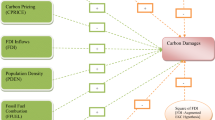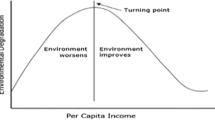Abstract
As countries compete to achieve a better economic freedom in the last decades, there is almost no empirical query on the likelihood of its environmental quality (de)merit and/or its effect on the attainment of Global Goals. In the case of Russia, the country with a relatively unimpressive economic freedom ranking according to Fraser Institute (2020) and Heritage.org (Heritage 2020), the current study examined the validity of the rise and fall hypothesis via-a-vis U- or inverted U-shaped hypothesis of economic freedom and carbon emissions in comparison to the rise and fall hypothesis of income-environmental degradation relationship. The study found a U-shaped hypothesis and an inverted U-shaped hypothesis for economic freedom-carbon emissions relationship in the short run and long run respectively as against an inverted U-shaped hypothesis for income-carbon emissions relationship in both terms. Moreover, coal, natural gas, and oil energy utilizations that are the country’s main energy sources exert a significant and damaging effect on the country’s environmental quality in the short and long run. However, the study posited that nuclear energy utilization in Russia has an environmental quality benefit in both short run and long run. Importantly, this study offers a significantly useful economic and energy policy for Russia, thus reenacting the country’s 2030 Global Goals outlook.


Similar content being viewed by others
Notes
The index of economic freedoom considered a comprehensive perspective of all aspects of economic freedom. In quantifying economic freedom index through a ranging method, the following 12 main perspectives were explored: rule of law, government size, regulatory efficiency, market openness, properrty right, judicial effectiveness, government integrity, fiscal health, labor freedom, monetary freedom, financial freedom, and investment freedom.Additional information is available at https://www.heritage.org/index/about.
References
Adedoyin FF, Bekun FV (2020) Modelling the interaction between tourism, energy consumption, pollutant emissions and urbanization: renewed evidence from panel VAR. Environ Sci Pollut Res 27(31):38881–38900
Adedoyin FF, Alola AA, Bekun FV (2020a) An assessment of environmental sustainability corridor: The role of economic expansion and research and development in EU countries. Sci Total Environ 713:136726
Adedoyin FF, Bekun FV, Alola AA (2020b) Growth impact of transition from non-renewable to renewable energy in the EU: the role of research and development expenditure. Renew Energy 159:1139–1145
Adedoyin FF, Nathaniel S, Adeleye N (2021) An investigation into the anthropogenic nexus among consumption of energy, tourism, and economic growth: do economic policy uncertainties matter? Environ Sci Pollut Res 28(3):2835–2847
Ahmed S, Ahmed K, Ismail M (2020). Predictive analysis of CO 2 emissions and the role of environmental technology, energy use and economic output: evidence from emerging economies. Air Quality, Atmosphere & Health, 1-10.
Alola AA, Donve UT (2021). Environmental implication of coal and oil energy utilization in Turkey: is the EKC hypothesis related to energy?. Management of Environmental Quality: An International Journal.
Apergis N, Ozturk I (2015) Testing environmental Kuznets curve hypothesis in Asian countries. Ecol Indic 52:16–22
Apergis N, Payne JE (2009) CO2 emissions, energy usage, and output in Central America. Energy Policy 37(8):3282–3286
Balsalobre-Lorente D, Shahbaz M, Roubaud D, Farhani S (2018) How economic growth, renewable electricity and natural resources contribute to CO2 emissions? Energy Policy 113:356–367
Balsalobre-Lorente D, Bekun FV, Etokakpan MU, Driha OM (2019) A road to enhancements in natural gas use in Iran: A multivariate modelling approach. Res Policy 64:101485
British Petroleaum, BP (2020). BP Statistical Review of World Energy June 2019. https://www.bp.com/en/global/corporate/news-and-insights/press-releases/bp-statistical-review-of-world-energy-2019.html. (Accessed 28 July 2020).
Etokakpan MU, Solarin SA, Yorucu V, Bekun FV, Sarkodie SA (2020) Modeling natural gas consumption, capital formation, globalization, CO2 emissions and economic growth nexus in Malaysia: Fresh evidence from combined cointegration and causality analysis. Energy Strategy Reviews 31:100526
Etokakpan MU, Saint Akadiri S, Alola AA (2021) Natural gas consumption-economic output and environmental sustainability target in China: an N-shaped hypothesis inference. Environmental Science and Pollution Research, 1-13.
Farhani S, Balsalobre-Lorente D (2020) Comparing the role of coal to other energy resources in the environmental Kuznets curve of three large economies. Chin Econ 53(1):82–120
Fraser Institute (2020). Economic Freedom. https://www.fraserinstitute.org/studies/economic-freedom. (Accessed 30 Jul 2020).
Grossman GM, Krueger AB (1991). Environmental impacts of a North American free trade agreement (No. w3914). National Bureau of economic research.
Grossman GM, Krueger AB (1995) Economic growth and the environment. Q J Econ 110(2):353–377
Heritage (2020). 2020 Index oof Economic Freedom. https://www.heritage.org/index/about. (Accessed 28 Jul 2020).
International Energy Agency (IEA, 2020). Russia. https://www.iea.org/countries/russia. (Accessed 09 Aug 2020).
Johansen S, Juselius K (1990) Maximum likelihood estimation and inference on cointegration—with appucations to the demand for money. Oxf Bull Econ Stat 52(2):169–210
Joshua U, Alola AA (2020). Accounting for environmental sustainability from coal-led growth in South Africa: the role of employment and FDI. Environmental Science and Pollution Research, 1-11.
Koyuncu T, Beşer MK, Alola AA (2021) Environmental sustainability statement of economic regimes with energy intensity and urbanization in Turkey: a threshold regression approach. Environ Sci Pollut Res:1–14
Lee J, Strazicich MC (2003) Minimum Lagrange multiplier unit root test with two structural breaks. Rev Econ Stat 85(4):1082–1089
Ozturk I (2010) A literature survey on energy–growth nexus. Energy Policy 38(1):340–349
Pao HT, Yu HC, Yang YH (2011) Modeling the CO2 emissions, energy use, and economic growth in Russia. Energy 36(8):5094–5100
Pesaran MH, Shin Y, Smith RJ (2001) Bounds testing approaches to the analysis of level relationships. J Appl Econ 16(3):289–326
Rudenko D (2018) Environment and economic growth in the Russian Arctic. International Journal of Global Environmental Issues 17(2-3):163–174
Saint Akadırı S, Alola AA, Usman O (2021) Energy mix outlook and the EKC hypothesis in BRICS countries: a perspective of economic freedom vs. economic growth. Environ Sci Pollut Res 28(7):8922–8926
Shahbaz M, Sinha A (2019) Environmental Kuznets curve for CO2 emissions: a literature survey. J Econ Stud
Shahbaz M, Balsalobre-Lorente D, Sinha A (2019) Foreign direct Investment–CO2 emissions nexus in Middle East and North African countries: Importance of biomass energy consumption. J Clean Prod 217:603–614
Stern DI (2004) The rise and fall of the environmental Kuznets curve. World Dev 32(8):1419–1439
Yang X, Lou F, Sun M, Wang R, Wang Y (2017) Study of the relationship between greenhouse gas emissions and the economic growth of Russia based on the Environmental Kuznets Curve. Appl Energy 193:162–173
Yang B, Jahanger A, Khan MA (2020) Does the inflow of remittances and energy consumption increase CO 2 emissions in the era of globalization? A global perspective. Air Quality, Atmosphere & Health, pp 1–16
Availability of data and materials
Not applicable
Author information
Authors and Affiliations
Contributions
Andrew Adewale Alola: writing—original draft, formal analysis, conceptualization, formal analysis, investigation, methodology.
Nnamdi Nwulu: writing—original draft and data curation.
Corresponding author
Ethics declarations
Ethical approval
Not applicable
Consent to participate
Not applicable
Consent to publish
Not applicable
Competing interests
The authors declare no competing interests.
Additional information
Responsible Editor: Ilhan Ozturk
Publisher’s note
Springer Nature remains neutral with regard to jurisdictional claims in published maps and institutional affiliations.
Rights and permissions
About this article
Cite this article
Alola, A.A., Nwulu, N. Income vs. economic freedom threshold and energy utilities in Russia: an environmental quality variableness?. Environ Sci Pollut Res 28, 35297–35304 (2021). https://doi.org/10.1007/s11356-021-14406-3
Received:
Accepted:
Published:
Issue Date:
DOI: https://doi.org/10.1007/s11356-021-14406-3





